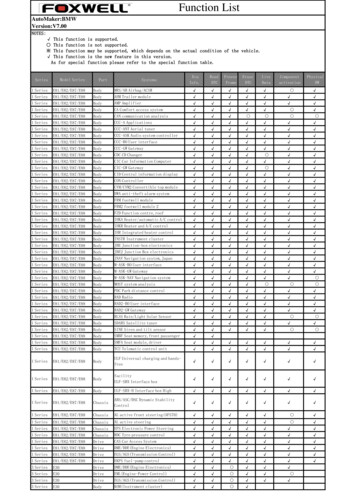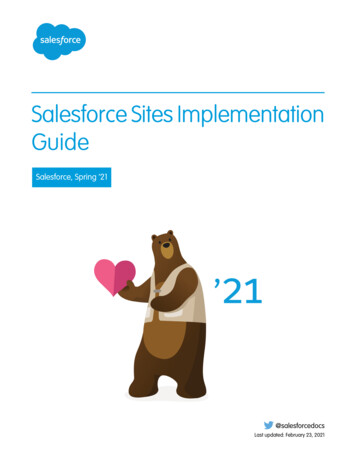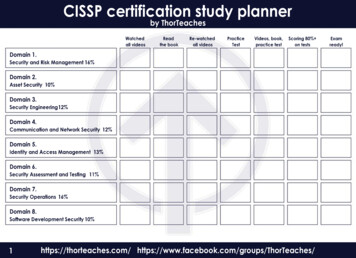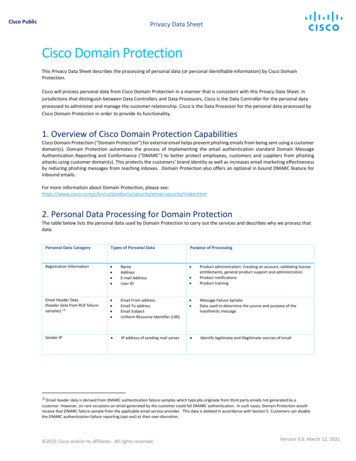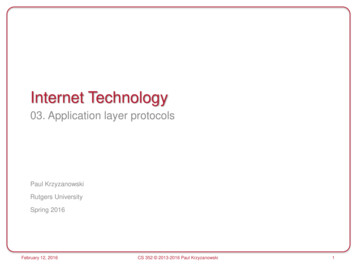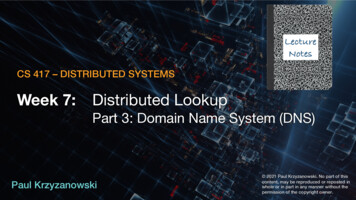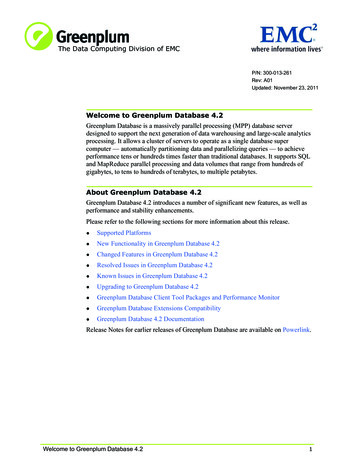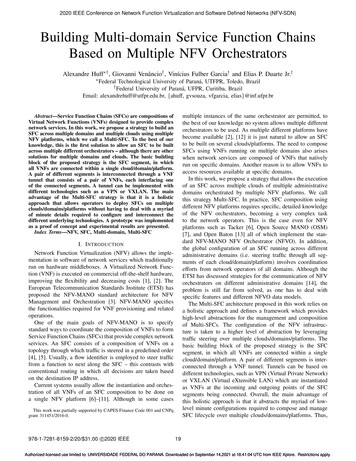
Transcription
2020 IEEE Conference on Network Function Virtualization and Software Defined Networks (NFV-SDN)Building Multi-domain Service Function ChainsBased on Multiple NFV OrchestratorsAlexandre Huff † , Giovanni Venâncio† , Vinı́cius Fulber Garcia† and Elias P. Duarte Jr.† FederalTechnological University of Paraná, UTFPR, Toledo, BrazilUniversity of Paraná, UFPR, Curitiba, BrazilEmail: alexandrehuff@utfpr.edu.br, {ahuff, gvsouza, vfgarcia, elias}@inf.ufpr.br† Federalmultiple instances of the same orchestrator are permitted, tothe best of our knowledge no system allows multiple differentorchestrators to be used. As multiple different platforms havebecome available [2], [12] it is just natural to allow an SFCto be built on several clouds/platforms. The need to composeSFCs using VNFs running on multiple domains also ariseswhen network services are composed of VNFs that nativelyrun on specific domains. Another reason is to allow VNFs toaccess resources available at specific domains.In this work, we propose a strategy that allows the executionof an SFC across multiple clouds of multiple administrativedomains orchestrated by multiple NFV platforms. We callthis strategy Multi-SFC. In practice, SFC composition usingdifferent NFV platforms requires specific, detailed knowledgeof the NFV orchestrators, becoming a very complex taskto the network operators. This is the case even for NFVplatforms such as Tacker [6], Open Source MANO (OSM)[7], and Open Baton [13] all of which implement the standard NFV-MANO NFV Orchestrator (NFVO). In addition,the global configuration of an SFC running across differentadministrative domains (i.e. steering traffic through all segments of each cloud/domain/platform) involves coordinationefforts from network operators of all domains. Although theETSI has discussed strategies for the communication of NFVorchestrators on different administrative domains [14], theproblem is still far from solved, as one has to deal withspecific features and different NFVO data models.The Multi-SFC architecture proposed in this work relies ona holistic approach and defines a framework which provideshigh-level abstractions for the management and compositionof Multi-SFCs. The configuration of the NFV infrastructure is taken to a higher level of abstraction by leveragingtraffic steering over multiple clouds/domains/platforms. Thebasic building block of the proposed strategy is the SFCsegment, in which all VNFs are connected within a singlecloud/domain/platform. A pair of different segments is interconnected through a VNF tunnel. Tunnels can be based ondifferent technologies, such as VPN (Virtual Private Network)or VXLAN (Virtual eXtensible LAN) which are instantiatedas VNFs at the incoming and outgoing points of the SFCsegments being connected. Overall, the main advantage ofthis holistic approach is that it abstracts the myriad of lowlevel minute configurations required to compose and manageSFC lifecycle over multiple clouds/domains/platforms. Thus,Abstract—Service Function Chains (SFCs) are compositions ofVirtual Network Functions (VNFs) designed to provide complexnetwork services. In this work, we propose a strategy to build anSFC across multiple domains and multiple clouds using multipleNFV platforms, which we call a Multi-SFC. To the best of ourknowledge, this is the first solution to allow an SFC to be builtacross multiple different orchestrators – although there are othersolutions for multiple domains and clouds. The basic buildingblock of the proposed strategy is the SFC segment, in whichall VNFs are connected within a single cloud/domain/platform.A pair of different segments is interconnected through a VNFtunnel that consists of a pair of VNFs, each interfacing oneof the connected segments. A tunnel can be implemented withdifferent technologies such as a VPN or VXLAN. The mainadvantage of the Multi-SFC strategy is that it is a holisticapproach that allows operators to deploy SFCs on multipleclouds/domains/platforms without having to deal with a myriadof minute details required to configure and interconnect thedifferent underlying technologies. A prototype was implementedas a proof of concept and experimental results are presented.Index Terms—NFV, SFC, Multi-domain, Multi-SFCI. I NTRODUCTIONNetwork Function Virtualization (NFV) allows the implementation in software of network services which traditionallyrun on hardware middleboxes. A Virtualized Network Function (VNF) is executed on commercial off-the-shelf hardware,improving the flexibility and decreasing costs [1], [2]. TheEuropean Telecommunication Standards Institute (ETSI) hasproposed the NFV-MANO standard architecture for NFVManagement and Orchestration [3]. NFV-MANO specifiesthe functionalities required for VNF provisioning and relatedoperations.One of the main goals of NFV-MANO is to specifystandard ways to coordinate the composition of VNFs to formService Function Chains (SFCs) that provide complex networkservices. An SFC consists of a composition of VNFs on atopology through which traffic is steered in a predefined order[4], [5]. Usually, a flow identifier is employed to steer trafficfrom a function to next along the SFC – this contrasts withconventional routing in which all decisions are taken basedon the destination IP address.Current systems usually allow the instantiation and orchestration of all VNFs of an SFC composition to be done ona single NFV platform [6]–[11]. Although in some casesThis work was partially supported by CAPES Finance Code 001 and CNPqgrant 311451/2016-0.c978-1-7281-8159-2/20/ 31.00 2020IEEE19Authorized licensed use limited to: UNIVERSIDADE FEDERAL DO PARANA. Downloaded on September 14,2021 at 18:41:04 UTC from IEEE Xplore. Restrictions apply.
Multi-SFCOrchestratorthe user with the permissions to set up a virtual network ineach domain can execute a Multi-SFC without the manualintervention of network operators.A proof-of-concept prototype was implemented based ontwo NFV platforms (Tacker and Open Source MANO) alongwith two different versions of OpenStack on two differentadministrative domains. Experiments are presented that wereexecuted to evaluate the Multi-SFC strategy in terms of interoperability and overhead. Results allow the conclusion thatthe Multi-SFC strategy is an effective solution, which to bestof our knowledge is the first NFV-MANO-compliant strategyto build SFCs across multiple clouds, multiple domains, andmultiple different NFV orchestrators.The rest of this paper is organized as follows. Section IIpresents related work. The Multi-SFC architecture is describedin Section III. The prototype and experiments are in SectionIV. Section V concludes the paper and presents future work.SFC Traffic FlowMulti-SFC OrchestrationVNF Tunnel Segment 1VNFVNFDomain 1 Segment 2VNFVNFVNF.VNFDomain 2 Segment NVNFVNFVNFDomain NFig. 1. Multi-SFC: Segmentation.decision process for SFC mapping. Another related work investigates strategies to deploy SFC across multiple datacenters[20] which takes into consideration not only cost, but also theusage of backup functions to improve SFC reliability.The 5G Exchange (5GEx) project [21] was defined to coordinate the allocation and efficient usage of compute, storage,and networking resources to deploy services in 5G networks.The 5GEx project relies on SDN and NFV techonologies forprovisioning services over multiple-technologies and spanningacross multiple 5G operators. 5GEx relies on a single NFVorchestrator. Finally, in [22] the authors propose a frameworkfor the orchestration of 5G network services across multipledomains. The objective is to optimize both resource utilizationand revenue, while matching service requirements.II. R ELATED W ORKFrancescon et al. proposed the X-MANO framework [15]which enables the orchestration of network services acrossmultiple domains. X-MANO only allows the composition ofpreviously created network services through specific NFVOinterfaces at each domain. X-MANO also requires manualconfiguration and instantiation of inter-domain links.A mechanism for the automated establishment of dynamicVirtual Private Networks (VPN) in the NFV context has beenrecently proposed [16]. The purpose is to provide encryptionand security to connect the functions of an SFC.The TeNOR NFV orchestrator [17] allows managementand control of the network services on distributed virtualizedinfrastructures. TeNOR automates SFC configuration and instantiation. Although a mapping-based solution is provided toinstantiate an SFC over multiple Points of Presence (PoPs),TeNOR does not allow to create SFCs across multiple different NFV orchestrators.OPNFV (Open Platform for NFV) [18] from the LinuxFoundation aims at simplifying the development and deployment of NFV components. OPNFV enables the interoperability of NFV solutions of different developers, but does notallow SFCs across multiple NFV orchestrators.Blue Planet MDSO (Multi-Domain Service Orchestration)[8] is a framework for composing and managing networkservices over multiple domains and NFV infrastructures. Despite of simplifying SFC configuration and instantiation, thisframework requires the usage of its own NFV orchestrator.Cloudify [9] is a project that allows the integration ofvirtual and physical network functions and provides an NFVOand a generic VNF Manager (VNFM) to orchestrate severalclouds. The system employs pre-configured virtual routersto interconnect different clouds through tunnels. AlthoughCloudify orchestrates several clouds, it does not allow SFCsto be constructed on multiple different NFV orchestrators.pSmart [19] allows SFCs on multiple domains to providecost-effective resource utilization. pSMART aims at reducingprivacy and security risks, and employs a learning basedIII. T HE M ULTI -SFCIn this section we describe the Multi-SFC solution forthe composition and management of SFCs distributed acrossmultiple clouds, domains, and NFV platforms. We assume thata domain is formed by a collection of systems and networksoperated by a single organization or administrative authority[3]. One or more clouds are hosted at each domain; each cloudruns an NFV platform which corresponds to a set of systemsrunning the NFV-MANO stack.The basic building block of a Multi-SFC is the segment, which consists of VNFs running on a singlecloud/domain/platform as shown in Fig. 1. A pair of differentsegments is interconnected through a VNF tunnel. Tunnels canbe based for instance on VPN or VXLAN technologies, andare instantiated as VNFs at the incoming and outgoing pointsof the SFC segments being connected. After a segment isinstantiated on a specific domain, it is connected to segmentsrunning on the other domains.The Multi-SFC Orchestrator shown in Fig. 1 is responsible for managing the Multi-SFC lifecycle, which consistsof the composition, instantiation, execution and destructionof a Multi-SFC on multiple domains/clouds/platforms. TheMulti-SFC Orchestrator provides a high-level and genericAPI (Application Programming Interface) to allow Multi-SFCcomposition and management. By using this interface the userspecifies the SFC as sequence of VNFs, and maps on whichcloud/domain each VNF is to be instantiated by the Multi-SFCOrchestrator.Fig. 2 shows the architecture of a Multi-SFC with twosegments split on a pair of domains. The Multi-SFC Or-20Authorized licensed use limited to: UNIVERSIDADE FEDERAL DO PARANA. Downloaded on September 14,2021 at 18:41:04 UTC from IEEE Xplore. Restrictions apply.
Multi-SFCOrchestratorSourceDestinationNFVOVNF 1unique identifier is employed by several operations to identifythe different segments that form a Multi-SFC.GET /catalog/domains: retrieves information of alldomains stored in the Domain Catalog. Information regardingall NVFO and VIM platforms as well as all VNF tunneltechnologies available on that domain is returned by thisoperation. This operation is employed by client applicationsfor instance, to check whether two different domains matchin terms of tunnel technologies available, and internally bythe SFC-Core to gather information about endpoints andauthentication methods available on each NFV platform.GET /catalog/vnfs/ dom-id / plat-id : listsall VNF packages stored in the Domain Catalog repositorybelonging to a specific domain dom-id . Since multipleNFV platforms are allowed, only compatible VNF packages( plat-id ) are returned by this operation.POST /msfc/sfp/compose: operation for the composition of a segment, which chains its VNFs. This operationreceives as input the domain, segment, and the VNF PackageID stored in the VNF Catalog. A single VNF is chainedper call of the operation, the input network interface of thisVNF is configured to be the previous VNF already in thechain. Unless there are several alternatives, the output networkinterface is configured automatically, otherwise the user isgiven a set of choices. Note that this approach allows chainingVNFs that act as branches allowing traffic to be sent ondifferent Service Function Paths (SFPs).POST /msfc/source: after the chain has been composed, the next task is to configure the incoming traffic. Theinput of this operation indicates whether the traffic source ofthe first segment of the Multi-SFC is internal or external. Incase of internal traffic, the Multi-SFC Core allows the userto chose as traffic source either a running VNF or a VNFPackage stored in the VNF Catalog. In case of external traffic,the network including the router are configured to allow theincoming traffic to be received.GET /msfc/acl/ sfc-id : returns all classifier policies of the NFV platform of the first Multi-SFC segment. Aclassifier policy is defined as an Access Control List (acl)that specifies attributes of the incoming traffic, such as sourceand destination addresses, ports, protocols, flow labels, etc.POST /msfc/acl: receives as input the policies specified by the user for the incoming traffic and configures thecorresponding SFC classifiers of the NFV platforms beingused along the Multi-SFC. Classifier policies of the next segments are mapped and configured taking into consideration theconfiguration of the first segment classifier and the differentNFV platforms being used.GET /tunnel/em: returns the Element Management(EM) of the VNF tunnels. The EM is used to configurethe tunnel. After it is instantiated, a VNF tunnel gets thecorresponding EM to configure itself.POST /msfc/start: this operation instantiates all segments of a Multi-SFC descriptor on their correspondingNFV domains and orchestrators. The Multi-SFC identifier isreceived as argument. The operation triggers the required op-VIMVNF 2VNF 3EMEMTUNTUNVNF 4VNF 5NFVOVNF 6Domain 1VIMVNF 7VNF 8Domain 2SFC Traffic FlowMulti-SFC OrchestrationFig. 2. A Multi-SFC split on a pair of domains.GUINFV OrchestratorVNFCatalogNFVInstancesNS CatalogClient ulti-SFC CoreDomainCatalogVNF ManagerVNFCatalogSFC Segment 1Multi-SFC InstancesSFC Segment 2SFC Instance 1Virtualized Infrastructure ManagerNFV-MANOVNFInstancesVNFPackagesClassifier DomainSFC Instance 2.Classifier Domain.SFC Segment NSFC Instance NClassifier DomainMulti-SFCFig. 3. The Multi-SFC Orchestrator architecture.chestrator does all the configuration required to steer trafficacross these segments. Tunnels implemented as VNFs areemployed to connect Multi-SFC segments across multipledomains becoming part of the SFC composition. This strategyallows transparent inter-domain communication, with a VNFimplementing a tunnel attached to the end of a segment andto the beginning of the next. According to the IETF SFCarchitecture [4] these tunnels correspond to Service FunctionForwarders (SFFs). In this context the Multi-SFC introducesthe support for the orchestration of multi-domain SFFs.Fig. 3 shows the Multi-SFC Orchestrator architecture whichis proposed as a generic and extensible solution aligned to thedefinitions of the NFV-MANO architecture. The NFV-MANOis also shown in the figure, illustrating its interaction with theMulti-SFC Orchestrator modules. The proposed architectureallows the integration of multiple NFV platforms and severalclient applications.The Multi-SFC Core is the main module of the Multi-SFCOrchestrator. This module is in charge of coordinating SFCcomposition on multiple NFV orchestrators, managing theMulti-SFC tunnels, as well as validating requests executed byclient applications. A centralized and generic communicationAPI is provided by the Multi-SFC Core presenting a RESTinterface for SFC composition and management. The MultiSFC Core leverages the VNF Tunnel Element Management(EM) to allow tunnel configuration. The main operationsof the API provided by the Multi-SFC Core to the ClientApplications to compose a Multi-SFC are described next.GET /msfc/uuid: generates and retrieves a unique identifier (uuid) in order to compose a new Multi-SFC (msfc). The21Authorized licensed use limited to: UNIVERSIDADE FEDERAL DO PARANA. Downloaded on September 14,2021 at 18:41:04 UTC from IEEE Xplore. Restrictions apply.
For each VIM, the correspondent VIM Driver must be available on the Multi-SFC Orchestrator.The VNF Catalog also in Fig. 3 is used to manage metadata of VNF Packages which are stored in the Multi-SFC Corerepository. The Domain Catalog provides meta-data requiredfor inter-domain communication, such as end-points, NFVorchestrator types, VIMs, as well as authentication data. TheVNF Instances keeps track of the different VNF instancesrunning on the multiple NFV platforms. Finally, the MultiSFC Instances stores and maps information related to eachSFC instance. Each stored instance keeps information aboutits Multi-SFC segments and their VNFs, information aboutremote SFC segment classifiers as well as information aboutthe domains and platforms hosting the segments. This allowsfor instance, to identify which particular SFC segment isrunning on a specific NFV platform, and also allows to releaseall cloud resources when destroying a service chain.erations to instantiate and configure the Multi-SFC, includingsending VNF Packages and SFC descriptors to the corresponding NFV platforms, instantiating VNFs and Multi-SFCsegments, configuring tunnels, configuring segment routing,and configuring security policies on each NFV platform. Thisoperation can only be executed to effectively instantiate andconfigure the whole Multi-SFC after the previous operationshave successfully created all the corresponding network service descriptors.The description of the Multi-SFC Core API above is nonexhaustive. Other operations include VNF Package management, VNF Descriptor management as well as operationsto instantiate, access, and destroy VNFs on the multipleclouds/domains/platforms.In addition to the Multi-SFC Core, Fig. 3 also shows bothNFVO Drivers and VIM Drivers. NFVO drivers are responsible for the abstraction of and communication with differentNFV orchestrators that can be employed by the Multi-SFCCore. Generic operations of the Multi-SFC Core are translatedby the NFVO Drivers to the specific operations and featuresof their corresponding NFV orchestrators. Each driver implements a set of functionalities that allow the composition andorchestration of SFCs, ranging from the management of VNFsand SFC descriptors to their instantiation and destruction.The main operations that a NFVO Driver must includeare those for the instantiation, monitoring and destructionof VNFs and SFCs and those to manage the Service Function Path (SFP), such as a compose sfp operation thatconnects VNFs along a Service Function Path of a particular Multi-SFC segment using information available atthe corresponding VNF Packages. Other operations include:get sfc traffic src retrieves VNFs eligible to beconfigured as traffic source of the first Multi-SFC segment.configure traffic src policy configures the SFCclassifier to encapsulate and forward the incoming trafficwhich can be internal or external. This operation selects in thecloud infrastructure the most appropriate network interfacesboth for internal (VNFs/VNF packages) and external (virtualrouters) traffic. Finally, there are also operations to manageclassifier policies. get available policies returns alist of policies and constraints which can be applied on agiven SFC segment classifier given the corresponding NFVplatform. configure policies configures the SFC classifier by defining constraints for the input traffic of eachSFC segment. This operation is in charge of setting up allthe Multi-SFC user policies related to the incoming traffic.get configured policies: returns the list of policiesconfigured by the Multi-SFC classifier. The Multi-SFC Coreleverages this operation to configure all classifiers of theMulti-SFC segments, all VNF tunnels, and firewalls rules onthe VIM network nodes.The VIM Drivers module is responsible for the transparentconfiguration of multi-domain and multi-platform interoperability. Each VIM Driver is employed to configure networks,manage inter-domain routing rules, and maintain the requiredsecurity policies for each corresponding Multi-SFC segment.IV. I MPLEMENTATION & E XPERIMENTSA Multi-SFC prototype was implemented as proof of concept1 . The implementation leverages several NFV enablers,in particular: OpenStack [23], Tacker [6], and OSM [7]. Inthe SFC context, the Multi-SFC itself can be regarded asan SFC enabler, since it abstracts and supports the composition and lifecycle management of distributed SFC segments.The OpenStack is employed as the NFV-MANO VIM whileTacker and OSM are the NFVOs. The Multi-SFC prototypewas implemented in Python. The Multi-SFC Core API exportsa REST interface which was implemented using the PythonFlask library. Both NFVO Drivers were implemented usingthe Python Requests library to communicate with their corresponding NFVO northbound interfaces. We also implementeda VIM Driver for the OpenStack platform using the PythonRequests library. Both orchestrators (Tacker and OSM) employ OpenStack to manage the lifecycle of VNFs and SFCs.While the NFVO Driver API abstracts the instantiation,query, and destruction of the Multi-SFC segments distributedon different domains and NFV orchestrators, the VIM DriverAPI abstracts the configuration required to interconnect thoseMulti-SFC segments across different domains. An EM wasimplemented to manage tunnel configuration and to enabletraffic steering across Multi-SFC segments. We used thePython Flask library to implement the EM and to providea REST API for the IP tunnel lifecycle management. Thislifecycle management is performed by the Multi-SFC Core.Each Multi-SFC tunnel is established on the specific endpointsof the segments after all VNFs have been instantiated. IPSec,VXLAN and GRE were employed to configure and instantiatethe VPN tunnels. The VIM Driver is used to configure routesand the security restrictions on the incoming traffic for eachsegment. Finally, Multi-SFC composition and classifier policyconfigurations were set up through a REST client application.Multi-SFC composition is based on the holistic workflow [24].1 Thesource code is available at rized licensed use limited to: UNIVERSIDADE FEDERAL DO PARANA. Downloaded on September 14,2021 at 18:41:04 UTC from IEEE Xplore. Restrictions apply.
--------- SFC Segment 1 --------- vServer 1HTTP DPIClientFirewallTUNHTTPS DPIDomain 1800APPGoodput (Mbps) -------- SFC Segment 2 -------- TUNBillingLoadBalancervServer 2VNFSFC Traffic FlowNon-SFC TrafficAPPDomain 26004002000Fig. 4. Multi-SFC evaluation scenario.Baseline LinkVXLANMulti-SFCGREIPSecFig. 5. Inter-domain TCP goodput using different VNF tunnels.Experiments were executed on two physical machines andother three virtual machines (VMs) running on a KVMvirtualization system. Each of the two machines run a differentOpenStack version, representing two different domains. Oneof these machines is based on an Intel(R) Core(TM) i76700HQ @ 2.6 GHz CPU with 4 cores; 6144K of L3 cache;12 GiB of RAM; Ubuntu 18.04. The other machine is anIntel(R) Core(TM) i7-6700 CPU @ 3.40GHz with 4 cores;8192K of L3 cache; 8 GiB RAM; Ubuntu 18.04. The threeVMs run on another machine based on the AMD Opteron(tm)Processor 6136 @ 2.4 GHz with 24 cores; 96 GiB of RAM;Ubuntu 20.04. Two different NFV orchestrators were used:Tacker and OSM each running on a separate VM. A third VMwith the same configuration was employed as the OpenStackcontroller for OSM, while the Tacker VM runs both theOpenstack controller and the NVFO. All VMs were set upwith 8 vCPUs, 8 GiB of RAM, and Ubuntu 18.04. Eachof the VNFs in this experiment runs Ubuntu Cloud 18.04virtual machines with 1 vCPU and 256 MiB of RAM. Physicalmachines were interconnected on a Gigabit Ethernet network.Fig. 4 shows the scenario used to evaluate the TCP goodputand latency of a Multi-SFC. We used iPerf3 to generate trafficfrom the client to the servers on another domain and tomeasure the corresponding TCP goodput. ICMP (ping) wasused to measure the latency. We implemented the FirewallVNF with iptables to filter and mark packets and iprouteto forward marked packets to different network interfaces(branches). Both DPI VNFs implement packet forwarding.The VNF tunnels were implemented with IPSec, VXLAN,and GRE. The Billing VNF was also implemented as a packetforwarder. The Load Balancer VNF was implemented withiptables and distributes the traffic to the servers based on ahash, which is computed from the source IP address. Thus,all connections of the same client are delivered to the sameserver in the pool. Actually, this is an iPerf3 requirement tomeasure the TCP goodput. iPerf3 requires the establishmentof at least two connections between the client and the server.Thus, all traffic of the experiment has to be sent to the sameserver even though there are other servers in the pool.Initially we measured the TCP goodput between the Clientand the TUN VNF in Domain 1, as well as between theTUN VNF and one vServer in Domain 2. This is a baselinemeasurement executed before the SFC was created. We ranthis experiment for 30 times of 60 seconds each. The goodputwas close to 37 Gbps in Domain 1 and 26 Gbps in Domain2. Since the Client, vServer, and both TUN VNFs ran onidentical virtual machines, the difference of the TCP goodputbetween both domains is related to the difference of the CPUsof the physical machines.Next, we created the two SFC segments and measuredthe impact of the TCP goodput on each independently. Notethat traffic was not forwarded from one domain to the otherdomain in this experiment. The measured TCP goodput forSegment 1 was on average 16.679 Gbps, while for Segment2 it was 9.648 Gbps. The reduction of the goodput is dueto fact that additional VNFs have been instantiated on eachsegment compute node. The SFC traffic is forwarded to andis processed by each VNF. Traffic classifiers for each segmentalso impose an overhead. Furthermore, the OpenStack virtualswitch uses veth pairs (virtual Ethernet devices that connectthrough the kernel). These devices are known to present poorperformance [25] but are used by OpenStack.We also executed an experiment to evaluate the impact ofthe TCP goodput running a complete Multi-SFC consistingof the two segments shown in Fig. 4. This experiment provided end-to-end measurements, traffic was steered throughall VNFs and between the two domains. As Segment 1 has abranch, traffic is steered to one of the DPI functions. IPSec,VXLAN, and GRE VNF tunnels were employed to implementthe tunnels. Fig. 5 shows the average for 30 executions of 60seconds each with 99% confidence intervals. Before we set upthe Multi-SFC we measured as a baseline the TCP goodputbetween the Client and one of the vServers without usingVNFs, SFCs and the IP tunnel. The average baseline goodputwas 932.1 Mbps. This results from the fact that the two VMsrunning the Client and the vServer are connected on a GigabitEthernet. When we executed the same measurement from theOpenStack compute nodes we got roughly the same results.We then executed an experiment for a complete Multi-SFCusing the VXLAN VNF tunnel. This experiment reached onaverage a goodput of 779.3 Mbps, as shown in Fig. 5. Thisresult was expected, since the VXLAN tunnel has an overhead(packet header sizes alone are increased by 50 bytes each).We also evaluated the TCP goodput for a complete Multi-SFCrunning a GRE VNF tunnel. GRE encapsulation adds at least24 extra bytes per packet. The Multi-SFC using GRE tunnelreached on average of 774.5 Mbps. We can conclude that GREand VXLAN tunnels had roughly the same performance.23Authorized licensed use limited to: UNIVERSIDADE FEDERAL DO PARANA. Downloaded on September 14,2021 at 18:41:04 UTC from IEEE Xplore. Restrictions apply.
Baseline LinkVXLANGREmultiple administrative domains should also be investigated.The interconnection of multiple domains using federations isalso a promising future work.IPSecLatency (ms)43R EFERENCES2[1] B. Yi, X. Wang, K. Li, S. k. Das, and M. Huang, “A comprehensivesurvey of network function virtualization,” Computer Networks, vol.133, pp. 212–262, 2018.[2] N. F. S. de Sousa, D. A. L. Perez, R. V. Rosa, M. A. Santos, andC. E. Rothenberg, “Network service orchestration: A survey,” ComputerCommunications, vol. 142-143, pp. 69–94, 2019.[3] J. Quittek, P. Bauskar, T. BenMeriem, A. Bennett, M. Besson, and etal, “Network functions virtualisation (NFV); management and orchestration. GS NFV-MAN 001 v1.1.1,” ETSI, Tech. Rep., 2014.[4] J. Halpern and C. Pignataro, “Service function chaining (SFC) architecture,” IETF, RFC 7665, October 2015.[5] V. F. Garcia, E. P. Duarte, A. Huff, and C. R. dos Santos, “Networkservice topology: Formalization, taxonomy and the custom specificationmodel,” Computer Networks, vol. 178, p. 107337, 2020.[6] Tacker, “Tacker - openstack NFV orchestration,” 2020. [Online].Available: https://wiki.openstack.org/wiki/Tacker[7] ETSI, “Open source MANO,” 2020. [Online]. Available:https://osm.etsi.org/[8] Ciena, “Blue planet multi-domain service orchestration (MDSO),”2020. [Online]. Available: https://www.blueplanet.com/products/mult
Blue Planet MDSO (Multi-Domain Service Orchestration) [8] is a framework for composing and managing network services over multiple domains and NFV infrastructures. De-spite of simplifying SFC configuration and instantiation, this framework requires the usage of its own NFV orchestrator. Cloudify [9] is a project that allows the integration of
